Infiltration anesthesia widely used in various surgical interventions. However, this type of pain relief is not indicated for use in all surgical cases.
Record content:
- 1 What is infiltration anesthesia?
- 2 Applications
- 3 How and how much does it work?
- 4 Pros and cons of infiltration pain relief
- 5 Indications for use
-
6 Types of infiltration anesthesia
- 6.1 Submucosa
- 6.2 Subperiosteal
- 6.3 Intraosseous
- 6.4 Intraligamentary
- 6.5 Intrapulpal
- 6.6 Intra-partition
- 6.7 Additional types
-
7 Anesthesia technique
- 7.1 Training
- 7.2 Drugs
- 7.3 Upper jaw
- 7.4 Lower jaw
- 8 Possible complications
- 9 Security measures
- 10 Price
- 11 Anesthesia video
What is infiltration anesthesia?
Infiltration anesthesia is a procedure for anesthetizing a part of the body with complete blocking of all conductive (nerve) impulses adjacent to this area. The anesthetic has an effect on the peripheral nervous system, penetrating through soft tissues.
Applications
This type of anesthesia is used for simple and short-term surgical interventions. Thus, anesthesia is performed before starting treatment of a hernia, when taking biological material for cytological studies, when removing the appendix and other simple surgical procedures.
Also, the anesthetic is used in various dental procedures.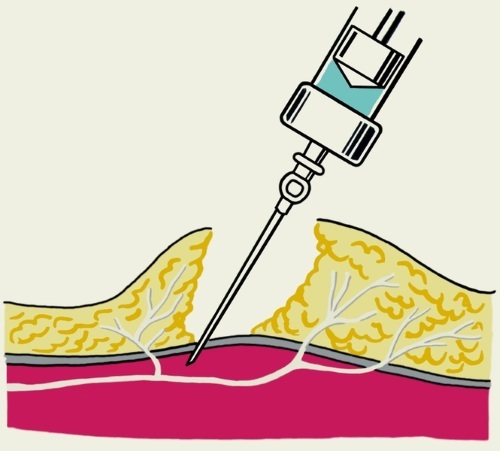
The blockade of nerve impulses by this method is not carried out when prescribing long-term surgical interventions, in the presence of malignant forms of neoplasms, as well as in the development of purulent processes in the problem area.
How and how much does it work?
After the injection, the components of the drug penetrate into soft tissues, stopping the transmission of nerve impulses through the peripheral nervous system. In this case, any painful sensations are suppressed for the duration of the action of the drug. The anesthetic acts locally, capturing a small area around the problem area.
The duration of anesthesia, on average, is 1 hour. However, in some cases, depending on the individual characteristics of the patient's body, the duration can increase up to 2.5 hours.
Pros and cons of infiltration pain relief
Infiltration anesthesia has both advantages and disadvantages compared to other types of anesthesia.
Pros:
- almost instant effect of the onset of pain relief;
- the possibility of using low doses of the drug, which significantly reduces its toxic ability;
- minimal ingress of anesthetics into the patient's body, due to the loss of some of the solution during the incision;
- hydropreparation ability;
- hemostatic effect due to the substances included in the solution;
- no need to take into account the location of nerve tissues.
Minuses:
- altered tissue position, which can cause certain difficulties in carrying out some surgical procedures;
- discoloration of tissues, which causes difficulties in identifying healthy and pathologically damaged areas;
- an increase in pain in the area of administration of the solution;
- lack of the possibility of full-fledged use of surgical procedures in the area of the facial skeleton.
These factors are taken into account in advance during the preliminary examination of the patient.
Indications for use
Anesthesia is performed to relieve pain during surgery.
General indications:
- inpatient or outpatient simple surgical procedures - removal of hernias, appendix, treatment of wound surfaces;
- surgical procedures performed without the participation of an anesthesiologist - scar treatment, removal of warts;
- urgent preoperative assistance.
Indications in dentistry:
- dental treatment - inflammatory processes in the gum area, the development of caries, pulpitis;

- interventions in the periodontal area - plastic surgery of the gums, including correction of misalignment;
- carrying out prosthetics in the presence of a tooth - installation of bridges, crowns;
- complex surgical and dental procedures - installation of implants, excision of cystic growths, removal of abscesses, extraction.
The use of an anesthetic solution is possible only if there are indications, as well as with an established diagnosis.
Types of infiltration anesthesia
Infiltration anesthesia is divided into several main types, depending on the area and method of application.
Submucosa
This type of anesthesia is the most common. When using it, a needle is injected into the area of the transitional fold from the vestibular side. In this case, the needle should be at an angle of at least 40-450 relative to the bone in the area of adhesion of the mucous membrane of the process of the alveoli.
After the injection into the marked area, the needle is gradually advanced to the upper part of the tooth root, after which the solution is injected.

When making an injection from the side of the palatine part into the area formed from the confluence of 2 processes - the alveoli and the palate. It should be borne in mind that the most preferred place of introduction will be the looser part of the fiber.
In some cases, the administration of anesthetic can be performed from the side of the alveolar ridge. A needle is injected into the area where the process of the alveoli smoothly passes into the region of the hyoid cavity.
Subperiosteal
This type of anesthetic is used in cases when the previous (submucous) type of injection is ineffective or it is necessary to achieve deeper anesthesia.
The needle is inserted into the area of the transitional fold in the region of the upper part of the root. Then the solution is slowly introduced. Then the needle is advanced until the supraspinous part is completely punctured and leads to the area of the tooth axis, smoothly moving towards its upper part.
Intraosseous
Injection of a needle with this type of anesthesia is performed in the area of the distal papilla located in the gum region. In this case, it is necessary to accurately hit its base.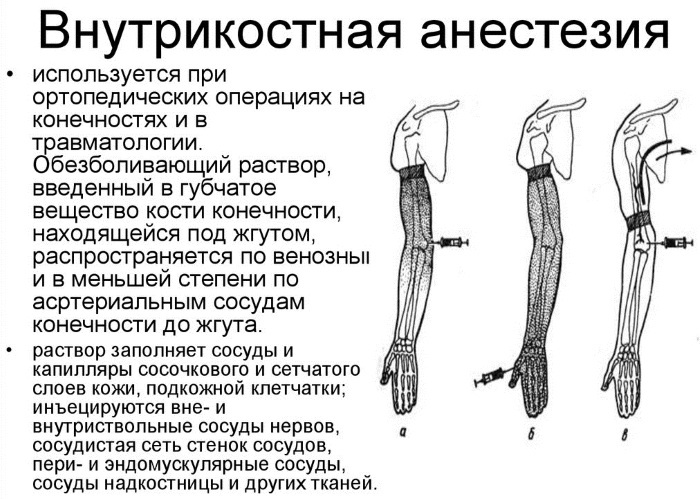
Upon reaching the interdental septum during the advancement of the needle, it is necessary to inject 1 drop of anesthetic agent. Then the needle is advanced further to the cortical plate and no more than 0.7 ml of solution is injected.
In the absence of an anesthetic effect, it is recommended to repeat the procedure, but in this case already from the side of the medial region of the diseased tooth.
Intraligamentary
Infiltration intraligamentary anesthesia is introduced into the area of the periodontal gap. The injection is made from the distal or medial side of the diseased tooth. The needle is placed in the area of the base of the papilla. In this case, the beveled part of the needle should be directed towards the diseased tooth, which will allow the solution to be evenly distributed.
When injecting an anesthetic, it must be borne in mind that the spread of the solution over the required area may be complicated. In this connection, the introduction of the drug is carried out within 1-2 minutes.
The procedure can be greatly simplified by using special ultra-thin medical needles.
Intrapulpal
When using this type of anesthesia, a special ultra-thin medical needle with a beveled edge is used. Before the injection, it is necessary to first open the marked area in the area of the pulp chamber. The hole formed must match the size of the medical needle.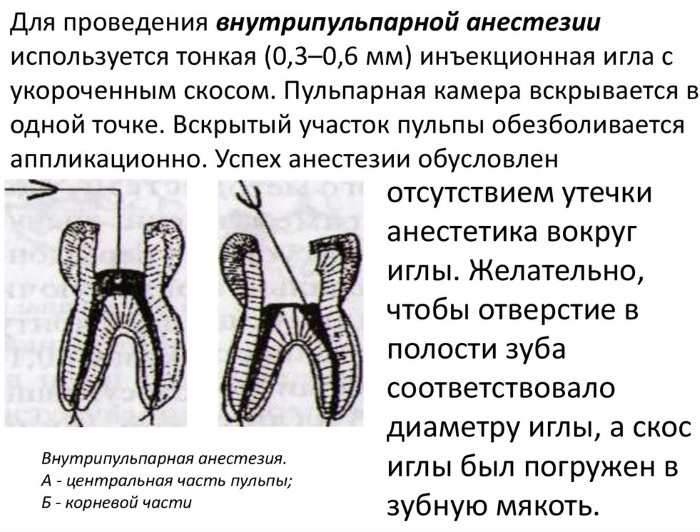
The positive effect is due to the absence of solution leakage from the needle. When inserting the needle, make sure that it penetrates into the soft part of the tooth (flesh). The most suitable area is the orifice located in the pulp area.
Intra-partition
In this type of anesthesia, the anesthetic is injected into the septum located between the alveoli of the adjacent teeth. Then the needle is advanced further into the septum to a depth of no more than 1-2 mm. Then the anesthetic is slowly injected into the bone itself.
Before using the injection, it is necessary to remove plaque, which can interfere with the accurate hit of the needle.
Intra-septal pain relief is often given to children.
Additional types
There are additional types of infiltration anesthesia that are rarely used.
Views:
- Intrapapillary type. For this type of pain relief, the anesthetic is injected into the area of the gingival papilla located between the teeth.
- Plexual. In this type, the injection is made into the area of the plexus of the alveoli.
- "Block field". This type of anesthesia is prescribed for the development of inflammatory processes in the area of soft tissues located in the peri-maxillary region.
-
Vishnevsky injection. When this injection is made, the anesthetic is injected layer by layer along the interfacial sections.
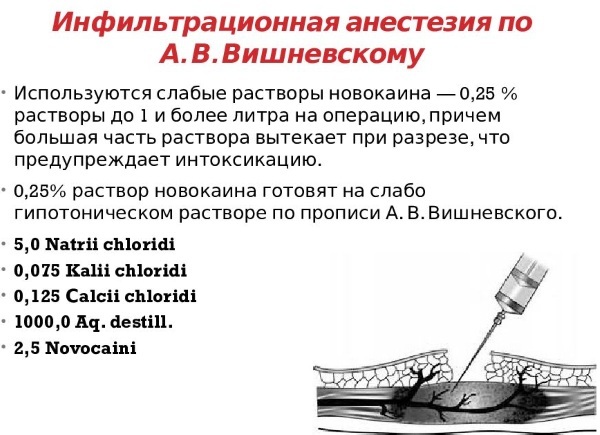
One or another type of anesthesia is selected by the attending physician, according to the established pathological process.
Infiltration anesthesia of other types is used only if the procedure and the components of the agent are well tolerated.
Anesthesia technique
When carrying out an injection, it is necessary to follow the rules for administering the solution and other recommendations that will help to avoid complications.
Training
Preparation for the injection includes the selection of instruments (syringes, needles) and their preliminary treatment with antiseptic agents.
Before applying the solution, the anesthetic area is also treated with antiseptic agents. After that, the anesthetic itself is injected directly.
Drugs
In most cases, 2 main types of pain relievers are used - lidocaine or novocaine. However, in some cases, drugs such as articaine, trimecaine, bupivacaine, and mepivacaine may be used.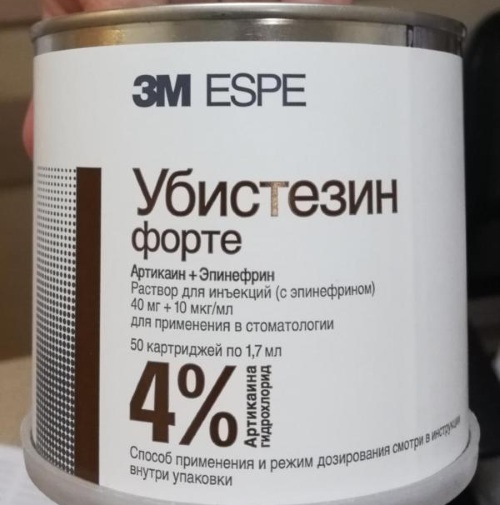
| Drug name | Active ingredient / composition | Features / characteristics |
| Ubistezan | Articaine hydrochloride, epinifrine | This drug belongs to the group of local anesthetic drugs in combination. The medication is produced in the form of a solution. The tool is used in surgical dental practice for pain relief. A solution is used immediately before the start of surgical actions. The dosage is calculated individually by the anesthesiologist according to the physiological characteristics of the patient. |
| Ultracaine | Articaine | This product is manufactured in Germany and is available in the form of a solution for local use (administration). The drug is used for the purpose of pain relief before surgical interventions in dentistry. The agent is introduced before the start of operational actions. The scheme of administration of the solution and dosage are calculated by the anesthesiologist, taking into account the patient's physiology. |
| Septanest | Articaine, epinephrine | France is engaged in the production of this tool. The drug is made in the form of a solution required for topical application. The drug is prescribed as infiltrative and conductive anesthesia. Anesthesia with a solution is carried out immediately before the start of surgical procedures. The dosage and other features of the administration of the anesthetic are determined by the attending physician (anesthesiologist). |
| Orablock | Articaine, alrenaline | This dosage form is produced as a topical solution. The drug is used as infiltration or conduction pain relief. A remedy is prescribed for dental surgical operations. A medication is prescribed shortly before the start of operational actions. The dosage of the solution and other features of the administration of the agent are calculated by the anesthesiologist according to the physiological characteristics of the patient. |
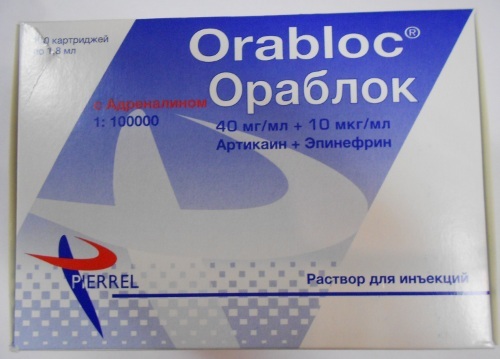
Some of these anesthetics can have a local absorbing effect, and therefore only low-toxic (or non-toxic) components are used in the manufacture of drugs.
To increase the time of action of the anesthetic, vasoconstrictor components are added to the composition of some drugs.
Upper jaw
In most cases, infiltrative anesthesia is performed in maxillary surgery, since this area is the least dense. For anesthesia of one tooth, the needle is inserted into the region of the fixed and movable part of the gum in the upper region of the tooth root, located slightly higher.
To stop the nerve fibers located in the region of the second premolars or molars, the solution must be injected into the base located near the dental root. In this case, the solution itself is injected into the cavity between healthy and diseased teeth.
It is also recommended to carry out anesthesia of the nerve parts, which are located in the angular space of the processes of the palate and alveoli.
Lower jaw
This type of procedure is performed in extremely rare cases, since the tissues in this area have a denser structure.
An anesthetic is used during surgical interventions associated with the removal of incisors. This is due to the fact that the anterior region of the bones located in the jaw has a softer structure and fewer microspores. Anesthetic solution is injected into the transition fold to the very base of the diseased tooth.
When anesthetizing all existing incisors, the solution is injected in a similar manner. When injecting the drug, it is necessary to move the needle to the right and to the left.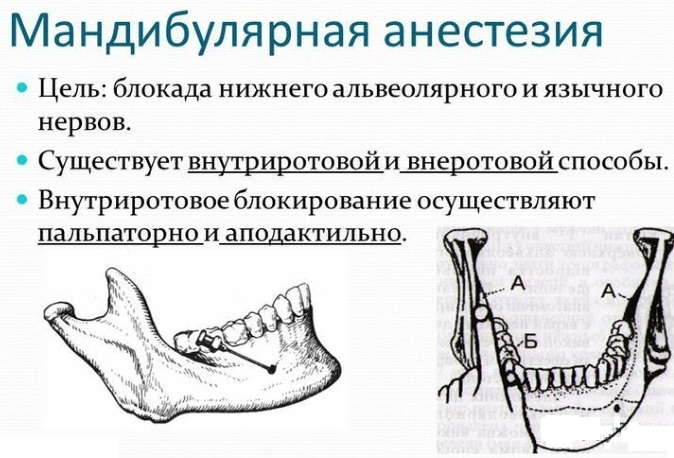
When anesthetizing the lingual nerve fibers, the drug is injected into the submucosa, located in the transition area - the space near the alveolar ridge. This type of anesthesia is used as an aid before tooth extraction or during any other simple surgical interventions.
Possible complications
Infiltration anesthesia, if used incorrectly, can lead to the development of complications.
Consequences:
- Insufficient level of pain relief. This process can develop with an incorrectly selected dosage or due to improper administration of the solution.
- Ligament rupture or tooth displacement. The development of this condition is due to the excessively rapid administration of the drug.
- The formation of hematomas. The process is associated with accidental puncture of blood vessels.
- Development of traumatic neuritis. The condition develops against the background of injury to the nerve trunk.
- Swelling, pain. The process of injury to the supraspinous part is caused. At the same time, a decrease in sensitivity is also noted.
- Necrotic tissue damage. The process is accompanied by the development of pain from the very beginning of the administration of the solution.
- The development of allergic reactions - the formation of swelling in the area of the tongue, throat, a decrease in the functions responsible for the patency of the airways.
- Development of infections. This process develops in the absence of antiseptic treatment, as well as when the solution is applied to an already infected area.
- Injury of muscle fibers located in the infratemporal fossa. In this case, there is a deterioration in the functions of the lower jaw. The condition is not dangerous and goes away on its own within a few days.
- Pinched facial nerve. Symptoms of this condition are: reflex eye disorders (blinking), drooping of the upper lip, inability to close the eyes.
- Intoxication. This condition is associated with exceeding the dose of the solution or its intravascular administration.
With the development of complications, the treatment of negative symptoms should be carried out only with the permission of a specialist.
Security measures
In order to avoid the development of complications or other negative reactions, certain recommendations must be followed.
Precautionary measures:
- During the procedure, the patient should remain calm and not make any movements.
- When injecting an anesthetic drug at the injection site, it is recommended to additionally apply an anesthetic application.
- The doctor carries out all actions in accordance with the established medical standards.
- To avoid getting the anesthetic substance into the bloodstream, you must first check that there is no blood in the needle. To do this, it is necessary to pull the syringe plunger towards yourself several times. In the presence of blood impurities, the injection site should be changed.
- When introducing an anesthetic component, it is necessary to observe the injection rate of the solution. The most preferred rate of administration of the drug is 1 ml in 10 seconds.
- In the absence of any anesthetic effect, additional anesthesia is performed using the intrapulpal method of introducing the solution.
- Do not inject the anesthetic into the area beyond the top of the root.
In case of psychoemotional instability caused by the upcoming procedure, it is recommended to take sedatives one day before the start of the operation. However, before taking such drugs, it is recommended that you first consult with an anesthesiologist.
Price
The cost of the procedure may differ depending on the area or region where the injection was made. At the same time, prices may vary slightly based on the medical institution. Thus, the cost of anesthesia in government clinics will be significantly lower.
Average prices for the procedure in Moscow and the Moscow region fluctuate around 380-410 rubles. In private medical services, the price for the service starts from 560 rubles. At the same time, an additional 100 rubles must be paid for auxiliary (conduction) anesthesia.
The cost of the infiltration type of anesthesia in St. Petersburg and its suburbs is from 360 rubles. In private clinics, you can get an injection from 450 rubles.
Anesthesia video
About anesthesia in dentistry:

